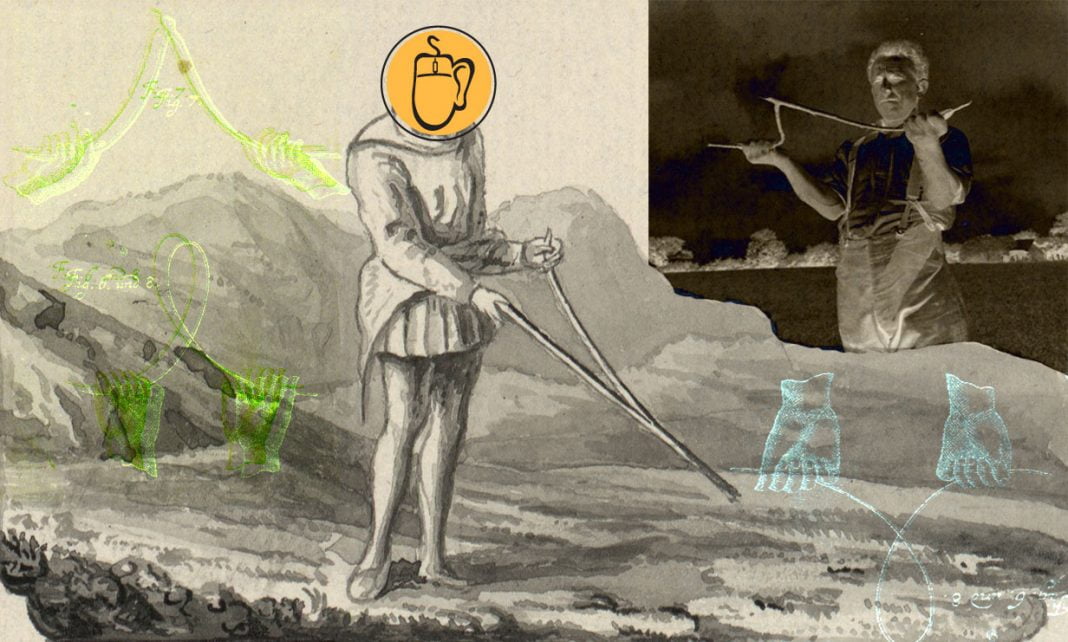Let’s talk about something weird, dowsing, and how it illustrates the power of marketing sincerity. My father was telling me a story about dowser. A property owner hired a dowser, a water witch, to help find where water was located. Instead of performing the water detection, the dowser showed the property owner how to find the water. The procedure worked. The property owner dowsed – the property owner detected the water.
IF you’re wondering how this concept can apply to marketing, I don’t blame you. How is this article going to explain something as weird and suspicious as dowsing as something having to do with marketing? How is this going to apply to any concept of sincerity? It seems in-congruent, but I’ll explain how it isn’t.
My ancestors from West Virginia dowsed generations back – they used the technique to find water, or at least try(?) to find water. Hearing my father talk about it made me wonder what was going on with dowsing. Is there some force that bends rods down, increasing gravity, magnetism, or something else to pull the rod down? Is the source of the movement something under the ground, moving the rods around? Is that likely?
Or does it have more to do with the person’s body moving the stick, the dowsing rod? Logic says that if the stick moves, and nothing else is touching it besides the person holding it, then its most likely movements caused by the person, not something else.
The property owner wasn’t conscious of moving the stick. But, and here’s the clincher: he doesn’t have to be aware of moving the stick in order to be the source of its movement. He might be moving the stick unaware. That’s the most likely case, even if he truly was sincere about not moving the stick himself, but feeling it move.
How does this relate with marketing? When you’re marketing to a single individual you’re not just marketing to one thing, the viewer’s conscious mind and awareness, but you’re also exposing the viewer to many different phenomenon simultaneously, most of which the viewer can’t be conscious of, but makes an impression on the viewer nonetheless.
For example an offer might state: “Save 50% on sneakers through Friday” and be presented on top of a professionally produced, graphic banner. The viewer might never be conscious of the colors, textures, images, symbols, tempo, tone, flavor or implications others might notice. All the viewer might take time to attend to is the value of the offer and how that plays into their expectations. The average viewer won’t have the mental time to spend on much more. Above and beyond the small amount of time an individual in an ad’s audience spends, there’s not a constant in terms of how the ad is perceived in terms of qualities. Each viewer attends to different phenomenon a single ad presents. Some look at the laces, some look at the soles. Some look at the colors, some ignore all that and do the mental calculations on price. The reaction and impressions aren’t black and white. They exist across a spectrum.
Attention and Awareness Don’t Limit the Impact of the Impression
A single banner ad might take hours to produce, maybe even days or weeks if custom photography is involved. This contrasts harshly against he reality of that ad’s insertion into the digital world. A digital viewer of the ad might only give less than a quarter of a second’s attention to it. It competes with the content of pages, other ads and other applications on other devices the viewer has to choose from.
Even though an ad might never gets a click from a viewer, the ad still makes an impression. Either the impression is conscious or never gets included in the viewer’s train of thought. The viewer sees and hears every element of the production although they might be conscious of only the most important part to them, or not aware of any elements at all.
Where Marketing Sincerity Impact the Impressions
Every part of what’s produced comes from someone, some producer or artist weaving together digital elements to yield a final piece. The smallest elements of what’s produced come together in a whole that reveals the intention and motivation of the producers. Everyone who is responsible for a piece’s approval has the opportunity to send the piece through another round of iteration before it’s released and published.
If a marketer is vested in what they’re promoting, truly believes themselves in the benefits versus costs of what they’re producing content for, then that content will contain elements and nuances within it that communicate a level of sincerity very difficult to achieve otherwise.
Today’s Audience is Jaded More Than Ever
Today’s audiences are savvy and mature in terms of consuming media no matter how simple that media is. Whether it’s a highly produced video piece, animated banner ad or simple text message, the intention of the messenger is more transparent today than it has ever been. Above and beyond spotting and consciously addressing spurious or insincere claims, today’s audiences have a lifetime of experiences with media, promises and failures to deliver upon expectations. They might not consciously be aware of what makes them tune an ad out. For each offer scoffed at consciously there’s a greater number that are simply ignored. The funnel narrows.
If anyone along the chain of production and approval isn’t sincerely vested in the message it infects the potential of the piece, ads especially. If a producer’s heart isn’t behind their work it might not be evident in the approval process but it certainly will be to the audience. If a marketer doesn’t believe, like an evangelist has to, in what they’re marketing the audience can tell.
Intuition is an Unconscious Calculation Factoring In Sincerity
Just like a dowser’s rod moving in the hands of it’s user, driven by the sum of unconscious impressions, there’s this thing that occurs within the mind of the audience, like a needle on a gauge moving. Let’s call it opinion or sentiment. The individual involved might attribute the movement of this needle of opinion inside themselves to their “intuition”, but really it’s a calculation that they’re just not aware of, taking place as mechanistically as the workings of a clock. The hands of the clock do not stay still. The needle is real and the needle more often from things the audience member is unaware of.
The degree of sincerity in a piece has a big impact on moving the needle.
Sincerity isn’t all sunshine and roses. Sincerity also inspires witch doctors to work dark magic on their victims, powered by the placebo effect that can harm as much as heal. A foundation of fear can pervade a piece to drive audiences to act against themselves, using the same degree of produced elements from a marketer who doesn’t have their audience’s interests at heart. Someone sincere about their own intention to profit, seeing their audience as only a resource, can consciously use these principles against their audience if they’re smart and experienced enough.
An insincere marketeer is essentially a manipulator, like an evil shaman, trying to use dark tactics against their audience. An effective evil shaman is scary but an ineffective one is a joke. There are a lot of examples of evil shaman work being effective in the past, for example cigarette ads. But things have changed today. It’s not as easy to be an effective evil shaman, manipulating people today. Audiences have matured too much, seen too much. They’ve been jaded.
People see through the mumbo-jumbo of an evil shaman too easy today, and are open about laughing at it. Look at how disconnected pharmaceutical ads are with their audiences. Most people scoff at them and how they’re delivered. It’s crystal clear that their intention isn’t to inform or benefit people suffering from the conditions they treat – instead it’s to maximize sales and profit by giving their audience a brand name to request from their physician. It’s made even more difficult thanks to the requirement to communicate dangerous sounding side-effects and interactions. This makes it seem almost like the manufacturer is intentionally selling poison for profit.
They Take The Money to Peddle What Appears as Poison
I doubt many marketers who work on drug ads think “this is going to improve the lives of this audience”. Instead they put on their ineffective evil shaman hats and take the money, knowing that what’s being produced is insincere poison nobody appreciates except the stakeholders who need ads produced according to their marketing plan. Nobody can produce a piece where time has to be spent on communicating dangerous side effects without being very conscious of the potential of the product to do more harm than good. But they take the money and produce the insincere piece anyway with goofy cartoons and smiling patients.
The good news is that it takes lot more to be an effective evil advertiser today, and that fewer and fewer ads are getting away with it. Audiences are habituated against the evil. But that doesn’t stop a lot of bad, ineffective ads from being produced. That doesn’t stop a lot of sincere stakeholders from getting taken advantage of. That doesn’t stop a lot of money from being wasted.
A Sincere Marketer Connects Deeper Than Awareness
On the flip side, a marketer who sincerely believes in what they’re promoting doesn’t have to be so experienced or smart. It helps, of course to be smart and experienced, but those aren’t requirements for communicating sincerity. A piece doesn’t have to be so slick if it is sincere. The force it takes to move that needle of impression, that internal dowsing rod inside each individual in an ad audience, is so much less when the intention is sincere.
This is one reason why there are “social media marketers”. Someone who is sincere, believes in the message as an evangelist, who has the experience and voice as a subject-matter-expert can drive audience engagement with a very small budget. People who are most effective at this are often recruited from within the company rather than those who offer it as an exclusively outsourced service. No marketer can be as sincere as an evangelist as the people who see customers benefiting each and every day.
Sincerity Requires Understanding
Software developers put time into understanding and affirming the requirements for something before the production occurs. One of the biggest reasons IT projects fail is because of poor requirements documentation, loosing sight of the needs of the users.
Requirements. Requirements. Requirements.
Marketing projects are the same. Affirming the goals and requirements of a produced piece, connecting with why it’s important, is just as critical. However, the complexity of yielding a deliverable is much less for marketing. It’s a lot easier to produce some banner ads or a video piece compared to producing an app. Likewise it’s a lot easier for marketers to skip over or ignore a requirements affirming step before production begins. A marketer who falsely assumes “I understand enough about this” and begins production is certain to produce a piece dripping with insincerity.
Let’s take for example the use case of selling a flashlight. A good marketer who takes time to explore the requirements of the campaign would put time into understanding why this flashlight is the best. How is it designed? What components does it use? Why is it better than any other flashlight at that cost?
An evil marketer doesn’t need to understand any of that. They might just prey upon the immediate fears of the audience, how much they’re afraid of the dark, and how horrifying it would be to be without a flashlight when it starts to get dark tonight. The problem with the evil marketer’s pitch is that any flashlight is just as good, and that without something specific known about this particular flashlight they’re essentially promoting their competition.
It’s not as easy or effective to be evil compared to being sincere. But there’s a lot of “pro-marketers” selling their clients bad campaigns that waste gobs of money on the premise that it’s still effective. It’s going to be less and less effective in the future as the approach is a vicious circle that creates more and more savvy audiences. These kids aren’t getting any dumber, believe me.
My advice to any up-and-coming marketers is to gather the requirements, take time to understand.
It’s counter-intuitive to add one more step to a process you’re trying to get through as quickly and profitably as you can. It’s against a lot of producer’s judgement to add one more step to their burdens. But adding the step of defining, documenting and affirming requirements is critical. Even beyond that getting an holistic understanding of the client, their competition, the audience and the market are key to making more effective.
Think of it like this: if you were in a hurry to get somewhere you’ve never been before it might feel best to simply get started moving in that direction. However, if you take the time to get a map, or plan your route before taking off, then the likelihood you won’t get lost or off track is increased. Getting a map makes sense just like defining requirements for something that has never been produced before can make or break an investment.
Gather the motivation to learn about whatever it is you’re promoting. Become a sincere evangelist or give up. If you can’t emotionally connect with what you’re promoting it will shine through in your work and end up doing your clients more harm than good. The dowsing rods in the minds of today’s audiences are real and they’re more important than ever.
















Thanks for the insight into markete’s motivation.